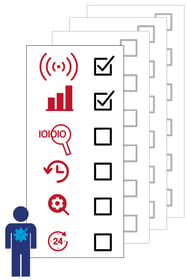The Demand Capacity Planner’s Success Checklist
Jesse Kelber - November 05, 2019

.png?width=366&name=the-demand-capacity-planners-success-checklist%20(1).png) There’s a coffee shop down the road known for ham & cheese croissants. So you stop by one morning only to discover that they’re out. The barista says they only get 3-4 each day and that they’re generally gone before 8:00 AM. The 2 people behind you sighed and said they were looking for the same thing. This is the best (and smallest scale) analogy I’ve ever seen for poor demand capacity planning. The shop knows there is a demand for the item, and they know the bakery makes more than they order, yet they never have enough to even come close to meeting demand. Leaving many unhappy, and unsatisfied, customers debating the breakfast options down the street. For you, the demand capacity planner, this is the scenario you dread more than anything—being unable to meet your customers’ demands and losing them to competitors as a result. Follow along with the following steps, and you’ll be on your way to avoiding this situation by keeping production and demand evenly matched.
There’s a coffee shop down the road known for ham & cheese croissants. So you stop by one morning only to discover that they’re out. The barista says they only get 3-4 each day and that they’re generally gone before 8:00 AM. The 2 people behind you sighed and said they were looking for the same thing. This is the best (and smallest scale) analogy I’ve ever seen for poor demand capacity planning. The shop knows there is a demand for the item, and they know the bakery makes more than they order, yet they never have enough to even come close to meeting demand. Leaving many unhappy, and unsatisfied, customers debating the breakfast options down the street. For you, the demand capacity planner, this is the scenario you dread more than anything—being unable to meet your customers’ demands and losing them to competitors as a result. Follow along with the following steps, and you’ll be on your way to avoiding this situation by keeping production and demand evenly matched.
Are you Making Full Use of the Technology You Already Have?
Say operations and IT recently installed IoT sensors on every piece of equipment on the factory floor. Ops has access to the data they’re producing in order to schedule preventive maintenance on the machinery, but how about your team? Even if those sensors are the first and only piece of Industry 4.0 infrastructure deployed at this time, you and your planners can make excellent use of them to help gauge the true capacity of the equipment. Not only that, but knowing about that preventive maintenance could also prove helpful so you can plan around any expected downtime. If you don’t have access to the data store yet, start the discussion with management to get it, then work with your analysts to establish the KPIs and metrics you’ll need to put that data to work for more accurate capacity planning.
How Accurate are your Demand Forecasts?
Being able to tap into not only your internal data, but also that being generated by your partner’s systems is crucial. Think about it this way: if that coffee shop knew ahead of time that their baker had oven space to make 12 ham & cheese croissants, and the baristas tell you that a dozen customers had expressed interest in that item, you would be silly not to order enough to meet that forecasted demand, right? Similarly, if you know your production floor can produce enough product to meet the exact demand being generated by advanced analytics running on your sales projections combined with historic sales data, you would also be silly not to ensure the factory was keeping up. Using data from deployed technologies like RFID tracking on orders, IoT sensors at the factory, and the advanced analytics made possible by AI, you can have the accuracy in forecasting you need to ensure production stays right where it needs to be, reducing both overstock and under-filled orders.
Are Your KPIs in Order?
Once you have your data sources and access sorted, it’s time to analyze. But what are you trying to get from this analysis? This is where setting concrete goals for your planning activities becomes crucial. Key performance indicators (KPIs) and other metrics are the way to do this, especially when you are about to dive into a massive pile of data. It doesn’t take long for that data to become overwhelming and send unprepared planners running back to pen and paper. Laying out your goals early on is the best way to avoid that fate. Start with the basics like indicators of upcoming demand fluctuations, forecasted versus actual sales, unplanned capacity adjustments, etc., and expand from there.
Advanced analytics will come into play as you work with these metrics. Primarily, you’ll be making use of what’s called predictive analytics, which is an analysis of your past orders, production levels, logistics, market conditions, and more in order to produce predictions for the coming season. Putting the power of advanced analytics to work for your capacity planning allows for an unprecedented level of agility and flexibility. The more touchpoints along your value chain from which you can incorporate data, the better, allowing for quicker pivots no matter where the potential discrepancy appears.
Real-Time Data Flows: Are You Using Them Effectively?
Much of the true power of advanced analytics comes into play when they’re implemented as real-time data analysis. As soon as a sensor collects data, it sends it to the data store making it available to your analytics solution instantaneously. That means that you can potentially cut your lead times drastically, further improving not only your capacity and logistics, but also making your customers happy. This real-time data flow eliminates surprises, your analytics will be able to predict upcoming fluctuations, machine breakdowns, and other potential disruptions, giving you time to adjust your expectations, production levels, or logistics plans accordingly, in order to keep the whole value chain more efficient.
Data: Ready to Accumulate, Integrate, and Assimilate?
The bottom line here is simple—once you have the infrastructure and technology in place, your demand capacity planning activities should be making use of everything Industry 4.0 has to offer. Starting with factory floor sensors and continuing through real-time analytics; your planning can be made more flexible and efficient. The sensors collect the data, sending it to a central data store. The accumulated data is then available to be integrated with data coming in from up- and down-stream on the supply chain. Once that’s complete, you’re ready to assimilate all that data using advanced analytics to produce the demand forecasting, capacity predictions, and sales forecasts that will take your planning to the next level of accuracy.
Your goal in demand capacity planning is to make sure your company is never in the situation my local cafe found itself in: having the ability to meet customer demands, yet not doing so whether due to an unwillingness to try or just because of bad planning. Stay on top of technological advances, monitor your KPIs, and ensure that you’re taking full advantage of the real-time data available to you and your customers won’t do what I did—walk down the street to the competitors.
LATEST POSTS
- Understand Why Production Planning Needs Specialized Solutions
- Understand Circular Economy in The Manufacturing Industry
- How Can Industry 4.0 IT Integration Be Achieved Smoothly?
- The Significance of Order Sequencing in Discrete Manufacturing
- How to improve your Supply Chain Management: The Power of Control Towers



